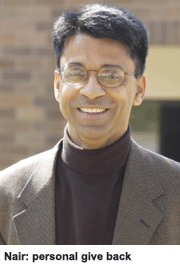 Education architect and co-founder of the globally renowned Fielding Nair International (FNI), US-based Prakash Nair’s passion is to create conducive learning environments around the world. Addressing a group of academic heavyweights on May 27 at the Grand Hyatt Hotel, Mumbai, Nair’s 60-minute lecture on ‘Learning by Design in the Creative Age’, which centred on how educational environ-ments can be transformed to induce creative and critical thinking, wowed the 54-strong audience.
Education architect and co-founder of the globally renowned Fielding Nair International (FNI), US-based Prakash Nair’s passion is to create conducive learning environments around the world. Addressing a group of academic heavyweights on May 27 at the Grand Hyatt Hotel, Mumbai, Nair’s 60-minute lecture on ‘Learning by Design in the Creative Age’, which centred on how educational environ-ments can be transformed to induce creative and critical thinking, wowed the 54-strong audience.
Promoted in 2003, FNI fuses the educational ideologies of Nair and his partner Randall Fielding, which are practiced through architectural con-cepts. With over 25 years experience as a planner, designer, curriculum consul-tant, and institutional architect, Nair was instrumental in FNI signing a joint venture agreement with the Mumbai-based DSP Design Associates Pvt. Ltd to transform India’s education landscape.
“India should not play second fiddle in innovation and miss the opportunity to leapfrog Western democracies. Our traditional education system celebrates students who excel in test-taking. But exam success doesn’t necessarily translate into career success and often destroys human potential,” says Nair, president of FNI and managing editor of DesignShare.com. “We provide an opportunity to break that cycle with student-centred as opposed to teacher-centred education.”
Under the terms of the FNI-DSP Design Associates collaboration agreement, DSP Design Associates (estb.1999), which has a headcount of 155 in six Indian cities, will import FNI designs into India and market them through a joint venture christened Education Design Architects India (EDA). “This is my personal way to give back to India,” says Nair.
An architecture graduate and valedictorian of Nehru Technological University, Hyderabad with Masters degrees in architecture, community and urban planning from the universities of Illinois, Iowa State and City University, New York, in the three decades past Nair has conceptualised, designed and commissioned education institutions and campuses in 29 countries around the world. “Schools we have planned or designed have won 11 international planning and design awards for excellence. Pertinently, our awards recognise not just quality architecture, but vastly improved educational outcomes as well,” he says.
The hallmarks of FNI-designed institutions are maximum space utilisation by eliminating corridors and creating multi-purpose areas, enhancing connectivity with nature, harnessing natural light and fresh air, and creating spaces for individual study and reflection. “Research indicates that brain function improves 10-25 percent by being able to look out of a window and access nature,” says Nair, also the co-author of The Language of School Design (2005).
EDA has drawn up a five-year education development plan for India. On the firm’s agenda is a project for designing 200 schools for 1 million low-income families. Another project, GlobalDevelopmentAcademy, is for 400 schools in tier-2 and tier-3 cities across the country and a third, is for a DiscoveryWorldSchool in Indore. “Each design will be congruous with Indian culture, history and climate and together they will serve as models to change the Indian education landscape and stimulate the development of thinking skills rather than exam success,” promises Nair.
God speed.
Nisha Khiani (Mumbai)